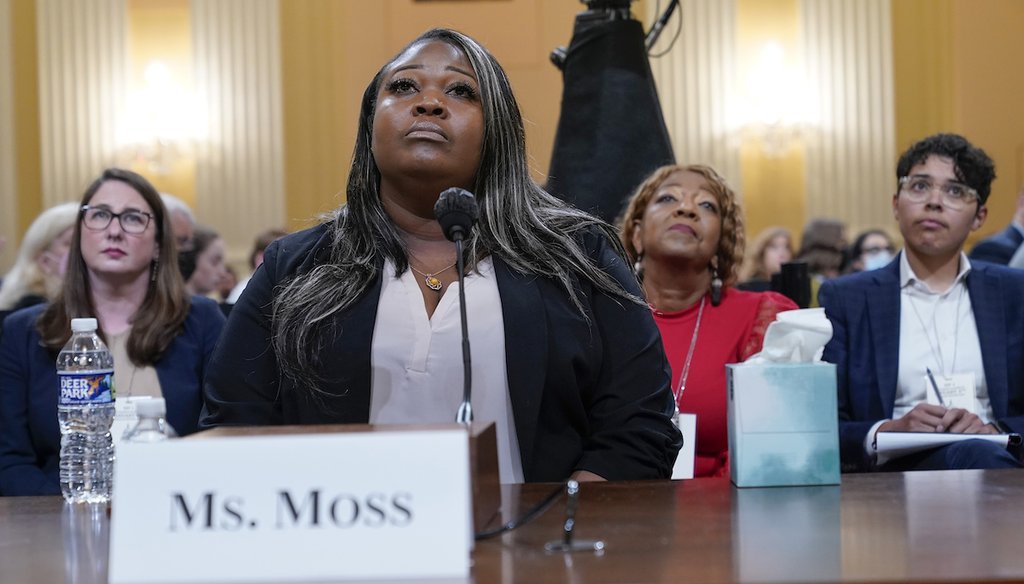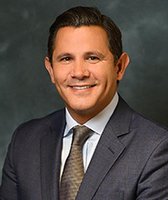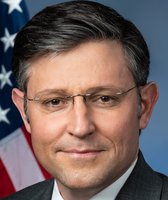Stand up for the facts!
Our only agenda is to publish the truth so you can be an informed participant in democracy.
We need your help.
I would like to contribute

Wandrea "Shaye" Moss, a former Georgia election worker who faced threats, testifies as her mother, Ruby Freeman listens, at a hearing of the House select committee investigating the Jan. 6 attack on the U.S. Capitol. (AP)
Election officials, lawmakers in Congress have faced increase in threats
If Your Time is short
-
A survey done early in 2022 on behalf of the Brennan Center found that 1 in 6 local election officials experienced threats.
-
A 2021 report by the U.S. Marshals Service showed that the number of threats against the judiciary or other federal court officials that resulted in investigations rose from 363 in 2017 to 1,343 in 2021.
-
Threats against members of Congress rose from 902 in 2016 to 9,625 in 2021.
The violent attack Oct. 28 on the husband of House Speaker Nancy Pelosi by a man who allegedly said "Where is Nancy?" is not an isolated example of threats facing government officials.
On NBC’s "Meet the Press" on Oct. 30, host Chuck Todd reeled off examples of instances in which public officials were violently threatened over the past decade. They included the armed man who was arrested near U.S. Supreme Court Justice Brett Kavanaugh’s home; a man sentenced for making death threats against Dr. Anthony Fauci, the nation’s leading infectious disease expert; and two shootings that targeted congressional members and left U.S. Reps. Gabby Giffords, D-Ariz., and Steve Scalise, R-La., seriously injured.
"Since former President Trump's election in 2016, the number of recorded threats against members of Congress has increased by 967%, that is not a typo folks, to more than 9,600 last year," Todd said.
Todd asked Sen. Amy Klobuchar, D-Minn., what she had learned about the attack against Paul Pelosi. Klobuchar reeled off a list of statistics about threats that public officials face.
"One in six local election officials have received threats of violence, doubling the number of threats against judges in just the last four-year period," Klobuchar said. "And then you've got, as you noted, elected officials in Congress, 10 times the amount of threats in a five-year period. This has to end."
A spokesperson for Klobuchar sent us a survey of election officials and reports or statements from federal sources about threats faced by court officials or members of Congress. Klobuchar’s numbers are generally correct but require context.
The increase in threats directed at public officials are driven by social and political divisions, as well as by how people process misinformation and disinformation, said Javed Ali, an associate professor who teaches courses on national security and domestic terrorism at the University of Michigan.
The hardest threats for law enforcement to thwart are those orchestrated by lone actors, like the man who went to Pelosi’s home.
"Unless a person is under investigation and on law enforcement’s radar, how would you know they are trying to put their own individual plot in motion?" Ali said.
The Brennan Center for Justice at New York University School of Law sponsored a survey of local election officials nationwide and published the results in March.
The Brennan Center purchased a list of about 9,000 election officials from the U.S. Vote Foundation and contacted everyone with a deliverable email address, inviting them to participate in the survey. Nearly 600 local election officials from across the country completed the online survey Jan. 31 to Feb. 14. The survey found that 1 in 6 local election officials had experienced threats and more than 3 in 4 reported that they felt threats had increased in recent years.
A similar survey was conducted for Brennan in 2021 and found similar results.
The threats against election officials followed the dissemination of falsehoods about voting and elections spread on social media and by former President Donald Trump and his allies. An election worker in Georgia said the FBI directed her to go into hiding after she was targeted with threats.
Election officials have taken steps to improve security such as installing cameras, adding plexiglass walls around equipment or reception areas and hiring security workers — or, in one case we know of, even wearing a bulletproof vest.
Colorado state lawmakers have passed bills since 2020 intended to protect election workers and voters, including a prohibition on openly carrying a firearm within 100 feet of a voting or ballot tabulation site during an election.
The Justice Department formed a task force in 2021 to investigate threats. Eight people have been charged, including one that predates the task force.
Sam Oliker-Friedland, a former voting rights lawyer at the Justice Department during the Obama and Trump administrations, told PolitiFact that physical security has always been a concern for election officials, but the scale of threats has risen since 2020. He said that local election officials need more money for security and that Congress should pass a proposal by a Senate committee to provide $400 million for election security grants. Oliker-Friedland is now the executive director of the Institute for Responsive Government, an organization providing governments with research, including on election infrastructure.
Featured Fact-check
Klobuchar’s office also pointed to documents from the U.S. Marshals Service showing that threats against federal court officials are on the rise.
The Marshals’ Service 2021 annual report showed in Figure 9 that the number of threats resulting in investigations rose from 363 in 2017 to 1,343 in 2021. That’s between a three- and fourfold increase, even more than the doubling cited by Klobuchar. The report also includes a broader category of inappropriate comments or threats to protected people, which rose from 2,847 in 2017 to 4,511 in 2021.
Klobuchar’s office pointed to articles by Reuters and CBS that describe the 4,000 figure as threats against federal judges. However, in the Marshals Service’s description of its duties, it said that it is responsible for the security of 2,700 federal judges and 30,300 federal prosecutors and court officials. A spokesperson for that agency didn’t readily have a number for threats that pertained only to judges compared with other protectees.
In 2016, Capitol Police investigated approximately 902 threatening communications, according to a letter written in 2017 by the U.S. House Office of the Sergeant at Arms. After Trump took office, threats against lawmakers rose each year for the next five years.
Data from the U.S. Capitol Police showed they investigated 3,939 threats against lawmakers in 2017, rising to 9,625 in 2021. The increase of 902 threats in 2016 to 9,625 in 2021 matches Klobuchar’s comment about a tenfold increase.
Nearly two years after the attack by pro-Trump supporters on the Capitol on Jan. 6, 2021, threats against lawmakers continue. The New York Times found that for threats that led to indictments, "more than a third were made by Republican or pro-Trump individuals against Democrats or Republicans deemed insufficiently loyal to the former president, and nearly a quarter were by Democrats targeting Republicans." The Times said data suggested threats were particularly acute against lawmakers of color — they outspent their white colleagues on security by about $17,500 on average.
Peter Simi, a sociology professor at Chapman University, said there isn’t a single factor to point to for the increase in threats but attributed it partly to the "Trump effect."
Starting in Trump’s 2016 campaign, Trump made comments that an ordinary listener would understand as tolerance for, and sometimes even a favorable disposition toward, physical violence.
Threats against high-profile politicians including presidents are not new but threats against lawmakers have surged, said Michael Jensen, principal investigator at the National Consortium for the Study of Terrorism and Responses to Terrorism at the University of Maryland.
"Since January 6th, groups like the Proud Boys have shifted their strategy, moving from a national to local focus ahead of the midterm elections," Jensen said. "These actors have mobilized in their communities to threaten and intimidate members of local school and health boards, county representatives, and judges."
Threats against lawmakers and other elected representatives are occurring along with an overall increase in political violence in the United States. A recent report by the FBI and Homeland Security shows that domestic terrorism investigations rose from about 1,000 in 2020 to more than 2,700 in 2021, Jensen said. Arrests rose from a little more than 100 to more than 800.
"These trends underscore the importance of voting to reinforce democratic processes as the legitimate means of political expression," Jensen said. "Votes can also send a message to political candidates that the mainstreaming of extremism will not be rewarded at the polls. "
Klobuchar said "one in six local election officials have received threats of violence," that threats against judges have doubled over four years and threats against members of Congress have increased by 10 times over five years.
A survey done for the Brennan Center earlier this year of about 600 local election officials nationwide found 1 in 6 faced threats. While Klobuchar singled out judges, federal data shows threats that were investigated against the judiciary and other federal court officials rose between three and four times between 2017 and 2021. The figure is closer to double if we look at a broader category of inappropriate comments and threats.
Threats investigated against members of Congress rose from 902 in 2016 to 9,625 in 2021.
We rate this statement Mostly True.
RELATED: Misinformation fuels false narratives about attack on Paul Pelosi
RELATED: No, the Pelosis aren’t withholding surveillance video from police
RELATED: Most states don’t explicitly ban guns at polls. Some lawmakers want to change that
Our Sources
Brennan Center for Justice, Poll of Local Election Officials Finds Safety Fears for Colleagues — and Themselves, March 10, 2022
Brennan Center, Local Election Officials Survey, June 2021
United States Marshals Service, Annual report, 2021
Paul Irving, Sergeant at Arms at the House of Representatives, Letter to the Federal Election Commission, June 21, 2021
United States Marshals Service FY 2023 Performance Budget, President’s budget, March 2022
U.S. Election Assistance Commission, Election security funds, 2018-2022
New York Times, Pelosi Attack Highlights Rising Fears of Political Violence, Oct. 29, 2022
NPR, Capitol Police Are Still Dealing With The Aftermath Of January 6th, Jan. 4, 2022
Vox, We’re in a new era of attacks on political leaders, Oct. 29, 2022
Senate Judiciary Committee, Testimony from election officials, Aug. 3, 2022
NBC, Skyrocketing Threats Prompt Concern For Safety Of Judges, May 21, 2021
Committee on Appropriations, Summary financial services and general government FY2023 appropriations bill, July 28, 2022
Telephone interview, Jane Meyer, U.S. Sen. Amy Klobuchar spokesperson, Oct. 31, 2022
Email interview, Barry Lane, U.S. Marshal’s Service spokesperson, Oct. 31, 2022
Email interview, Joshua Stueve, Justice Department spokesperson, Oct. 31, 2022
Email interview, Rebecca Autrey, Brennan Center for Justice spokesperson, Oct. 31, 2022
Email interview, Sam Oliker-Friedland, executive director of the Institute for Responsive Government, Oct. 31, 2022
Email interview, Michael Jensen, principal investigator, National Consortium for the Study of Terrorism and Responses to Terrorism (START) at the University of Maryland, Nov. 1, 2022
Telephone interview, Javed Ali, associate professor of practice at the Ford School of Public Policy at University of Michigan, Nov. 1, 2022
Email interview, Pete Simi, associate professor of sociology at Chapman University, Nov. 1, 2022
Browse the Truth-O-Meter
More by Amy Sherman
Election officials, lawmakers in Congress have faced increase in threats
Support independent fact-checking.
Become a member!
In a world of wild talk and fake news, help us stand up for the facts.












































